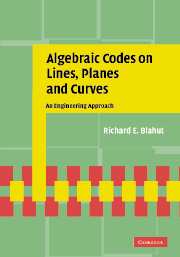Book contents
- Frontmatter
- Contents
- List of figures
- List of tables
- Preface
- Dedication
- 1 Sequences and the One-Dimensional Fourier Transform
- 2 The Fourier Transform and Cyclic Codes
- 3 The Many Decoding Algorithms for Reed–Solomon Codes
- 4 Within or Beyond the Packing Radius
- 5 Arrays and the Two-Dimensional Fourier Transform
- 6 The Fourier Transform and Bicyclic Codes
- 7 Arrays and the Algebra of Bivariate Polynomials
- 8 Computation of Minimal Bases
- 9 Curves, Surfaces, and Vector Spaces
- 10 Codes on Curves and Surfaces
- 11 Other Representations of Codes on Curves
- 12 The Many Decoding Algorithms for Codes on Curves
- Bibliography
- Index
4 - Within or Beyond the Packing Radius
Published online by Cambridge University Press: 05 October 2009
- Frontmatter
- Contents
- List of figures
- List of tables
- Preface
- Dedication
- 1 Sequences and the One-Dimensional Fourier Transform
- 2 The Fourier Transform and Cyclic Codes
- 3 The Many Decoding Algorithms for Reed–Solomon Codes
- 4 Within or Beyond the Packing Radius
- 5 Arrays and the Two-Dimensional Fourier Transform
- 6 The Fourier Transform and Bicyclic Codes
- 7 Arrays and the Algebra of Bivariate Polynomials
- 8 Computation of Minimal Bases
- 9 Curves, Surfaces, and Vector Spaces
- 10 Codes on Curves and Surfaces
- 11 Other Representations of Codes on Curves
- 12 The Many Decoding Algorithms for Codes on Curves
- Bibliography
- Index
Summary
The geometric structure of a code over a finite field consists of a finite set of points in a finite vector space with the separation between any two points described by the Hamming distance between them. A linear code has the important property that every codeword sees the same pattern of other codewords surrounding it. A tabulation of all codeword weights provides a great deal of information about the geometry of a linear code. The number of codewords of weight ω in a linear code is equal to the number of codewords at distance ω from an arbitrary codeword.
Given any element, which we regard geometrically as a point, of the vector space, not necessarily a codeword, the task of decoding is to find the codeword that is closest to the given point. The (componentwise) difference between the given point and the closest codeword is the (presumed) error pattern. A bounded-distance decoder corrects all error patterns of weight not larger than some fixed integer τ, called the decoding radius. A bounded-distance decoder usually uses a decoding radius equal to the packing radius t, though this need not always be true. In this chapter, we shall study both the case in which τ is smaller than t and the case in which τ is larger than t, though the latter case has some ambiguity. In many applications, a bounded-distance decoder is preferred to a complete decoder.
- Type
- Chapter
- Information
- Algebraic Codes on Lines, Planes, and CurvesAn Engineering Approach, pp. 190 - 223Publisher: Cambridge University PressPrint publication year: 2008



